railway
 James Edwin Wide had lost both his legs in a work accident years earlier, and so in 1880, when he came across a Chacma Baboon driving an oxcart while visiting a busy South African market, he saw a way to make his life easier. Wide was impressed with the skills, and so he decided to buy him. Having two peg-legs and working had been very difficult on Wide over the years, and finally he saw an end to years of hardship. Impressed by the primate’s skills, Wide bought him, named him Jack, and made him his pet and personal assistant. His original plan was to have Jack drive him on his half-mile commute to the train station. So the first thing he trained the Jack to do was push him to and from work in a small trolley. Soon, Jack was also helping with household chores, sweeping floors and taking out the trash. Jack was very good at his work, and he truly loved Wide, almost as if Wide was his child.
James Edwin Wide had lost both his legs in a work accident years earlier, and so in 1880, when he came across a Chacma Baboon driving an oxcart while visiting a busy South African market, he saw a way to make his life easier. Wide was impressed with the skills, and so he decided to buy him. Having two peg-legs and working had been very difficult on Wide over the years, and finally he saw an end to years of hardship. Impressed by the primate’s skills, Wide bought him, named him Jack, and made him his pet and personal assistant. His original plan was to have Jack drive him on his half-mile commute to the train station. So the first thing he trained the Jack to do was push him to and from work in a small trolley. Soon, Jack was also helping with household chores, sweeping floors and taking out the trash. Jack was very good at his work, and he truly loved Wide, almost as if Wide was his child.
While Jack was very good at his caregiving job, it was at the signal box Jack truly shined. The signal box was a system of manual switches operated in connection with the approaching trains whistles. As trains approached the  rail switches at the Uitenhage train station, they would toot their whistle a specific number of times to alert the signalman which tracks to change. By watching his owner, Jack picked up the pattern and started tugging on the levers himself. Jack was so smart. He was able to totally take over the signalman’s job that had been held by Wide. Soon, Wide was able to kick back and relax as his furry helper did all of the work switching the rails. According to The Railway Signal, Wide “trained the baboon to such perfection that he was able to sit in his cabin stuffing birds, etc, while the animal, which was chained up outside, pulled all the levers and points.”
rail switches at the Uitenhage train station, they would toot their whistle a specific number of times to alert the signalman which tracks to change. By watching his owner, Jack picked up the pattern and started tugging on the levers himself. Jack was so smart. He was able to totally take over the signalman’s job that had been held by Wide. Soon, Wide was able to kick back and relax as his furry helper did all of the work switching the rails. According to The Railway Signal, Wide “trained the baboon to such perfection that he was able to sit in his cabin stuffing birds, etc, while the animal, which was chained up outside, pulled all the levers and points.”
One day, as the story goes, an upper-class train passenger, looked out the window of the train and saw that a baboon, and not a human, was manning the gears. Of course, this brought outrage, and a complaint to the railway authorities. The authorities decided not to act in haste and fire Wide, decided to resolve the complaint by testing the baboon’s abilities. The result of that test was a group of astounded officials. “Jack knows the signal whistle as well as I do, also every one of the levers,” wrote railway superintendent George B Howe, who visited the baboon sometime around 1890. “It was very touching to see 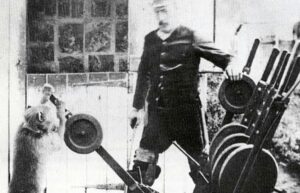 his fondness for his master. As I drew near they were both sitting on the trolley. The baboon’s arms round his master’s neck, the other stroking Wide’s face.”
his fondness for his master. As I drew near they were both sitting on the trolley. The baboon’s arms round his master’s neck, the other stroking Wide’s face.”
The complaint was disregarded and Jack was reportedly given an official employment number, and was paid 20 cents a day and half a bottle of beer weekly. Jack passed away in 1890, after developing tuberculosis. It was a sad day for all who knew him. Jack had worked the rails for nine years, without ever making a mistake. That shows that animals can be trained to do things in a responsible way, and do their job perfectly.

 My husband, Bob and I love to go to Denver, Colorado periodically. We usually try to go to a Rockies game, shop some, and walk a lot. I think that most people who live in Wyoming, and elsewhere across the nation, have made the trip to Denver periodically. It is a shopping hub for this area, and on top of that, it is a huge cultural hub too. Denver is not a city I would want to live in, because I really don’t care to live in such a big city, but I do enjoy going there occasionally.
My husband, Bob and I love to go to Denver, Colorado periodically. We usually try to go to a Rockies game, shop some, and walk a lot. I think that most people who live in Wyoming, and elsewhere across the nation, have made the trip to Denver periodically. It is a shopping hub for this area, and on top of that, it is a huge cultural hub too. Denver is not a city I would want to live in, because I really don’t care to live in such a big city, but I do enjoy going there occasionally.
I do wonder how I would have felt about Denver in it’s early days. Back in 1858, Denver was just a small frontier town in the Colorado Territory. In those days, the town was not called Denver, in fact, I don’t know if it even had an official name. In a city where shopping brings in a huge amount of revenue, Denver, on this day October 29, 1858, saw its first store open. One month later, the town would take on the name Denver in a ploy to gain favor from Kansas Territorial Governor James W Denver. The town was promoted by a real estate salesman from Kansas named William H Larimer Jr. The store was created to serve miners, who were working the placer gold deposits 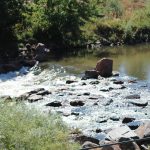
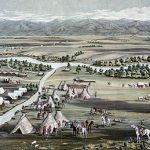 that had been discovered a year before at the confluence of Cheery Creek and the South Platte River. By 1859, tens of thousands of gold seekers had flooded into the area, but by then the placer deposits were already playing out and most miners quickly departed for home or headed west into the mountains in search of richer deposits.
that had been discovered a year before at the confluence of Cheery Creek and the South Platte River. By 1859, tens of thousands of gold seekers had flooded into the area, but by then the placer deposits were already playing out and most miners quickly departed for home or headed west into the mountains in search of richer deposits.
The area where the gold had been found is called Confluence Park, and it is one of our favorite places in Denver, because of the beautiful trail that leads to it. Strangely, in all the years that Bob and I have been going to Denver, and all the years that we have been walking that trail, and enjoying that park, we never knew of the history that happened there. I suppose we might have if we lived in Denver, or even in Colorado, but since we don’t, it was simply a nice walking trail with a nice park, in a city we enjoy going for a visit, and it always will be that, but it is also a piece of history, and now I know that.
In 1860, the frontier town of Denver almost failed before it got started, because even though it was centrally 
 located for servicing the mining camps, it didn’t have rail or water transportation to make bringing in the needed goods to the store easier, or even feasible. Even when the transcontinental Union Pacific Railroad was built, it didn’t initially stop at Denver, so the little town struggled, but by 1870, Denver finally began to overcome it’s geographical isolation, when the Kansas Pacific Railroad arrived from the east, and the 105 mile Denver Pacific Railway that joined Denver to the Union Pacific line at Cheyenne. More connections would come later on, making Denver the city it is today.
located for servicing the mining camps, it didn’t have rail or water transportation to make bringing in the needed goods to the store easier, or even feasible. Even when the transcontinental Union Pacific Railroad was built, it didn’t initially stop at Denver, so the little town struggled, but by 1870, Denver finally began to overcome it’s geographical isolation, when the Kansas Pacific Railroad arrived from the east, and the 105 mile Denver Pacific Railway that joined Denver to the Union Pacific line at Cheyenne. More connections would come later on, making Denver the city it is today.
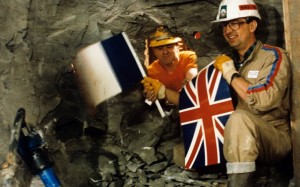 Since my dad was stationed in England during World War II, and because many of my ancestors come from England, I am interested in all things English. Of course, that doesn’t mean that I know everything about England, and I think it would be pretty difficult to do that with any country, including the country I live in…the United States. That said, I learned something about England today. England is an island nation as most people know, and that can make travel to mainland Europe difficult and expensive. Travel to Hawaii would be a good example of that, and Hawaii isn’t even it’s own nation. Nevertheless, most of us have to save up our money to make the trip to Hawaii.
Since my dad was stationed in England during World War II, and because many of my ancestors come from England, I am interested in all things English. Of course, that doesn’t mean that I know everything about England, and I think it would be pretty difficult to do that with any country, including the country I live in…the United States. That said, I learned something about England today. England is an island nation as most people know, and that can make travel to mainland Europe difficult and expensive. Travel to Hawaii would be a good example of that, and Hawaii isn’t even it’s own nation. Nevertheless, most of us have to save up our money to make the trip to Hawaii.
So, what does that have to do with England, you might ask. Well…everything. While an alternate mode of transportation to get to Hawaii…other than ship or plane, is not feasible for Hawaii…for England, maybe it could be. As early as the days of Napoleon Bonaparte, in 1802, people were looking for a way to connect England to France. Nothing came of those early suggestions, because the necessary technology was not available until the 20th century. The proposal was that since England and France were no longer at war, they should permanently connect their countries by way of a tunnel. The Channel Tunnel, later dubbed the Chunnel runs from Folkestone, England to Calais, France. The tunnel is 31 miles across, but in total there are 95  miles of tunnels. There are two railway tunnels, and a service tunnel. The work began on in 1986, and took four years to connect the two sides. Approximately 13,000 workers dug the 95 miles of tunnels at an average depth of 150 feet below sea level. Eight million cubic meters of soil were removed, at a rate of about 2,400 tons per hour. When it was finished, the Chunnel would have three interconnected tubes, including one rail track in each direction and one service tunnel. It cost $15 billion to complete.
miles of tunnels. There are two railway tunnels, and a service tunnel. The work began on in 1986, and took four years to connect the two sides. Approximately 13,000 workers dug the 95 miles of tunnels at an average depth of 150 feet below sea level. Eight million cubic meters of soil were removed, at a rate of about 2,400 tons per hour. When it was finished, the Chunnel would have three interconnected tubes, including one rail track in each direction and one service tunnel. It cost $15 billion to complete.
Most of us don’t give much thought to tunnels, but when it comes to underwater tunnels…well, that is just different. Of course, we all know of the Holland Tunnel that connects New York and New Jersey, but that tunnel isn’t nearly as long as the Chunnel. The Holland Tunnel is a little over a mile and a half, which pales by comparison to the Chunnel’s 31 miles. On December 1, 1990, after four long years of work, the two sides of the Chunnel were connected. Workers exchanged French and British flags and toasted each other with champagne. It was a great day. The Channel Tunnel finally opened for passenger service on May 6, 1994, with Britain’s Queen Elizabeth II and France’s President Francois Mitterrand on hand in Calais for the inaugural run. A company called Eurotunnel won the 55 year contract to operate the Chunnel, which is the crucial stretch of the 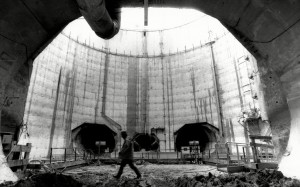 Eurostar high speed rail link between London and Paris. The regular shuttle train through the tunnel runs 31 miles in total, with 23 of those underwater and it takes 20 minutes, with an additional 15 minute loop to turn the train around. The Chunnel is the second-longest rail tunnel in the world, after the Seikan Tunnel in Japan.
Eurostar high speed rail link between London and Paris. The regular shuttle train through the tunnel runs 31 miles in total, with 23 of those underwater and it takes 20 minutes, with an additional 15 minute loop to turn the train around. The Chunnel is the second-longest rail tunnel in the world, after the Seikan Tunnel in Japan.
Things like this fascinate me. I like the idea of something as unique as the Chunnel. I like the interesting fact that it is in England. And I like the fact that, the Chunnel is the longest underwater section, longest international tunnel, second-longest railway tunnel in the world. Some day, I hope to ride the train through that tunnel. Wouldn’t that be amazing?
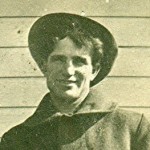 The Great Northern Railway was created in September of 1889. The line was the dream of one man…James Jerome Hill. He was called the Empire Builder, because of his ability to create prosperous business seemingly from nothing. It came to be as a result of the combining of several predecessor railroads in Minnesota and eventually stretched from Lake Superior at Duluth to Minneapolis/St Paul west through North Dakota and Northern Idaho to Washington State at Everett and Seattle. The Great Northern Railway was in operation until 1970 when it merged with the Northern Pacific Railway, the Chicago, Burlington and Quincy Railroad and the Spokane, Portland and Seattle Railway to form the Burlington Northern Railroad. The Burlington Northern Railroad operated until 1996, when it merged with the Atchison, Topeka and Santa Fe Railway to form the Burlington Northern and Santa Fe Railway.
The Great Northern Railway was created in September of 1889. The line was the dream of one man…James Jerome Hill. He was called the Empire Builder, because of his ability to create prosperous business seemingly from nothing. It came to be as a result of the combining of several predecessor railroads in Minnesota and eventually stretched from Lake Superior at Duluth to Minneapolis/St Paul west through North Dakota and Northern Idaho to Washington State at Everett and Seattle. The Great Northern Railway was in operation until 1970 when it merged with the Northern Pacific Railway, the Chicago, Burlington and Quincy Railroad and the Spokane, Portland and Seattle Railway to form the Burlington Northern Railroad. The Burlington Northern Railroad operated until 1996, when it merged with the Atchison, Topeka and Santa Fe Railway to form the Burlington Northern and Santa Fe Railway.
I’m sure you are wondering why I would be telling you this. It’s because this particular railroad played a part in my family’s past. My grandfather (my dad’s dad) worked on the Great Northern Railway. My dad and his siblings had passes to ride the Great Northern Railway for free, as a dependant of an employee. I think it is much of the reason that my whole family loves trains and riding on trains.
Grandpa was a wanderer. He loved to see new places and experience new things. The railroad gave him the ability to do just that…and also kept him away from his family a lot, unfortunately. My grandpa was born 133 years ago today..that seems an impossible number. My grandfather was 77 years older than me. He passed away in 1951, 5 years before I was born. My dad drove back to Wisconsin, making the 1000 mile trip in 17 hours, which was pretty quick back in the 50’s. He did make it to his dad’s side before he passed away on October 19, 1951.
Because he passed away before I was born, I don’t know much about my grandfather. I  have to think though, that there was a bit of a little boy in him that he never outgrew. His smile indicated that he had a great sense of humor, with just a hint of mischievousness. I think that his boyish grin could very well have been the very thing that caught my grandmother’s eye. I think he was always full of boyish charm and mischief, and a need to see what was around the next turn in the road…or in this case, the next curve of the tracks.
have to think though, that there was a bit of a little boy in him that he never outgrew. His smile indicated that he had a great sense of humor, with just a hint of mischievousness. I think that his boyish grin could very well have been the very thing that caught my grandmother’s eye. I think he was always full of boyish charm and mischief, and a need to see what was around the next turn in the road…or in this case, the next curve of the tracks.

